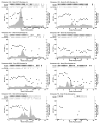Challenge pools of hepatitis C virus genotypes 1-6 prototype strains: replication fitness and pathogenicity in chimpanzees and human liver-chimeric mouse models
- PMID: 20353362
- PMCID: PMC2941994
- DOI: 10.1086/651579
Challenge pools of hepatitis C virus genotypes 1-6 prototype strains: replication fitness and pathogenicity in chimpanzees and human liver-chimeric mouse models
Abstract
Chimpanzees represent the only animal model for studies of the natural history of hepatitis C virus (HCV). To generate virus stocks of important HCV variants, we infected chimpanzees with HCV strains of genotypes 1-6 and determined the infectivity titer of acute-phase plasma pools in additional animals. The courses of first- and second-passage infections were similar, with early appearance of viremia, HCV RNA titers of >10(4.7) IU/mL, and development of acute hepatitis; the chronicity rate was 56%. The challenge pools had titers of 10(3)-10(5) chimpanzee infectious doses/mL. Human liver-chimeric mice developed high-titer infections after inoculation with the challenge viruses of genotypes 1-6. Inoculation studies with different doses of the genotype 1b pool suggested that a relatively high virus dose is required to consistently infect chimeric mice. The challenge pools represent a unique resource for studies of HCV molecular virology and for studies of pathogenesis, protective immunity, and vaccine efficacy in vivo.
Conflict of interest statement
Potential conflicts of interest: none reported.
Figures

References
-
- Gottwein JM, Bukh J. Cutting the gordian knot—development and biological relevance of hepatitis C virus cell culture systems. Adv Virus Res. 2008;71:51–133. - PubMed
-
- Lemon SM, Walker CM, Alter MJ, Yi MK. Hepatitis C virus. In: Knipe D, Howley P, Griffin D, et al., editors. Fields Virology. 5. Philadelphia, PA: Wolters Kluwer, Lippincott Williams & Wilkins; 2008. pp. 1253–1304.
-
- Simmonds P, Holmes EC, Cha TA, et al. Classification of hepatitis C virus into six major genotypes and a series of subtypes by phylogenetic analysis of the NS-5 region. J Gen Virol. 1993;74:2391–2399. - PubMed
-
- Simmonds P, Bukh J, Combet C, et al. Consensus proposals for a unified system of nomenclature of hepatitis C virus genotypes. Hepatology. 2005;42:962–973. - PubMed
Publication types
MeSH terms
Grants and funding
LinkOut - more resources
Full Text Sources
Other Literature Sources

